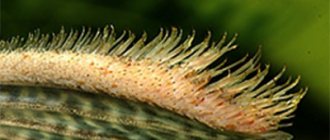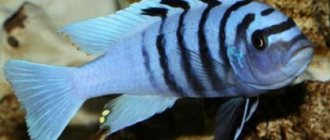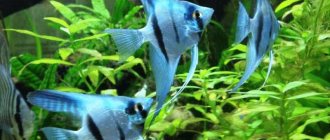by fisher December 18, 2015 0 Comments
Family: Chain catfish
soms
Hypancistrus zebra , known among aquarists as the imperial pleco or L-046, belongs to the chain-mail catfish family (Loricarudae). The fish received its scientific name relatively recently, in 1991, when the species was described by ichthyologists Isbrücker and Nijssen, and until that time they could only be identified by a special code L-046.
The genus name Hypancistrus comes from the Greek words "hypo" and "agkistron", meaning "below" and "hook" respectively. The origin of the species name “zebra” is more obvious and was given to the fish for its similarity in color to the black and white wild African horse.
Hypancistrus zebra
The first deliveries of fish to Europe, in the mid-eighties, were carried out under the commercial name “Zebra-Peckoltia”. The genus Pelkotia is very close to the genus Hypancitrus , many species have similar colors. This similarity was at one time abused by some unscrupulous suppliers, sending less brightly colored pecoltia hypancistrus
Zebra hypancistrus are small - their size is only 8-12 centimeters.
They have a typical shape for chain-mailed catfish, with an elongated muzzle and high-set large eyes, and are black and white in color, in the form of alternating stripes. Moreover, on the head, up to the dorsal fin, the stripes are transverse, then run along the body, at a certain angle, ending at the caudal fin. In the oral cavity, on the upper jaw there are 8 teeth on both sides, while on the lower jaw there are only 4. The upper teeth are longer than the lower ones, curved and forked at the end. The lower teeth are also quite deeply bifurcated. The tail of catfish is forked, V-shaped.
Hypancitrus zebra
The habitat of the species is the basin of the Xingu River, which is one of the many tributaries of the Amazon and flows in the northeast of Brazil. The reservoirs of the Xingu Basin have soft, slightly acidic, close to neutral water. The same water is desirable in an aquarium for keeping these fish.
Keeping zebra hypancitruses in an aquarium
Hypancitrus zebra species is quite flexible in terms of adaptability to the environment, so it easily adapts to different conditions. In aquarium practice, there have been cases of hypancitrus even in hard water with an alkaline reaction. Much more critical are water parameters such as temperature and oxygen saturation. The temperature in the aquarium should not go beyond the range of 23-30°C. in addition to this, round-the-clock aeration is needed. If anyone is still interested in specific numbers, then they are as follows: temperature 24–26°C, hardness – 5–14dGH, pH from 6.2 to 7.4. Powerful filtration is needed, which, in addition to its main purpose, would create some kind of current in the water.
The content of harmful nitrogen compounds in water, such as ammonium and nitrites, should not be allowed to increase; their concentration should be close to zero, and the level of nitrates should be maintained at an acceptable level by replacing the water weekly (30% of the volume) with fresh water.
It is very important that the hydrochemical parameters of the water remain stable, since any sudden fluctuations can cause the death of fish. Changes in behavior, such as lack of appetite or excessive lethargy, signal an unfavorable situation, in such cases it is recommended to replace 50% of the water in the aquarium and increase its temperature to 30 ° C, and use some kind of adsorbent, such as zeolite, in the filter as a filler or activated carbon.
To maintain a nest consisting of one male and several females, an aquarium with a volume of 100 liters or more is required. Zebra hypancistrus have a calm disposition and are suitable for keeping in any mixed aquariums with peaceful fish species.
The ideal option for arranging an aquarium with zebra hypancitruses is a species one, decorated in the style of a natural biotope. Which is a small watercourse with a fairly fast current, the bottom of which is strewn with a large number of different stones and pebbles, alternating with sandy areas. It is believed that fish prefer to stay at depth, since it is in such places that they are caught in nature.
Hypancistrus zebra
Zebra hypancitruses are lovers of various kinds of shelters, in the form of caves and crevices, therefore such places must be present in the aquarium with them. It is still unknown whether this species requires the presence of wood in the aquarium, as some other catfish require it, promoting better digestion. It will not be superfluous if you place a small piece of driftwood or a piece of wood in the aquarium.
Zebra hypancitruses are nocturnal, so they begin to actively feed at dusk. The fish spend almost all their time at the very bottom, only occasionally rising to the surface. They are indifferent to aquarium plants, so they can be kept in a herbalist. But dense thickets of plants will make the life of fish more comfortable.
Compatibility
Catfish are peaceful by nature and usually do not bother their neighbors. However, they are not very suitable for keeping in a community aquarium.
They need very warm water, strong currents and high oxygen levels, and they are also shy and easily refuse food in favor of more active neighbors.
There is a great desire to keep Hypancistrus zebra with discus fish. They have the same biotopes, temperature, and water requirements.
Only one thing does not match - the strength of the current that is needed for a zebra. The kind of flow that the hypancistrus needs will carry the discus around the aquarium like a ball.
It is best to keep Hypancistrus Zebra L046 in a separate aquarium, but if you want to match them with neighbors, you can take fish that are similar in content and do not inhabit the lower layers of water.
These can be characins - erythrozonus, phantom, cuneiform rasboras, cyprinids - cherry barbs, Sumatran.
These are territorial fish, so it is better not to keep other catfish with them.
Sexual dimorphism
Zebra hypancitruses sexually mature only at two years of age, which is quite late for such a relatively small fish.
It cannot be said that sexual dimorphism is somehow expressed in the appearance of fish. But there are a number of signs by which it is possible to determine the sex of adult zebra hypancitrus . Firstly, males are larger and slimmer than females. If you look at the fish from above, the male’s head is slightly wider than that of the female, and the first ray of his pectoral fin is noticeably thicker. In addition, there are spines on the rays of the male’s ventral fins.
Breeding zebra hypancitrus in an aquarium
Breeding fish in an aquarium is fraught with certain difficulties. Firstly, for spawning, fish need a fairly spacious aquarium, which should provide high-quality filtration and powerful aeration. As mentioned above, the level of nitrogen compounds in water should tend to zero, and the concentration of dissolved oxygen, on the contrary, should be quite high. The incentive for spawning is the presence in the aquarium of many different kinds of shelters, in the form of caves, crevices between stones, sections of ceramic pipes and clay flower pots laid on their sides. And the water temperature rises to 29°C.
Zebra hypancistrus love all kinds of shelters
As a rule, pairs form freely from a group of fish. If the aquarium is a species aquarium, then spawning occurs in it; if it is a communal aquarium, then the fish should be placed in a spawning tank. Another condition for successful breeding is that there must be many producers! Those aquarists who manage to regularly breed hypancistrus in captivity keep 8-14 adult fish. The peak of spawning activity occurs in July-September.
If the spawners refuse to spawn, try replacing a large amount of water (50-70% of the volume) by lowering its temperature by several degrees, imitating the process that occurs in nature with the onset of the rainy season. Repeat this procedure every 2 or 3 days, maybe this will give an impetus to spawning.
During the spawning process, the female lays 100-130 eggs in small portions (10-15 eggs) in her chosen shelter, while the male each time swims up fertilizes the next clutch, while guarding the entrance to the cave. The caviar is large - 1.5 mm in diameter, white-yellow in color. At the end of spawning, the male drives away his partner. And he takes upon himself all the worries about the future offspring.
The incubation period, depending on the temperature, lasts about a week. The yield of larvae is quite low, 20-25% of the total amount of eggs. Because hatching occurs only from peripheral eggs, and the rest of the eggs die.
The emerging larvae feed on the yolk sac for another 3-4 days. Sometimes it is difficult to notice the moment of hatching, since the larvae are extremely small. At this time they do not swim yet. As soon as the larvae have turned into fry and swam, they begin to be fed. When the fry appear, the male should also be removed. The fry do not tolerate sudden changes in their living conditions, so it is very important to keep them stable.
Zebra Hypancistrus larvae
Starter food - Artemia nauplii, tiny rotifers and special dry food intended for fry. If the fry are provided with a balanced diet, then after a month they grow up to 2 cm. As the fry grow, their diet must be diversified by adding various tablets (Spirulina, Vitabin, etc.), and then chopped tubifex. Over time, the fry begin to scrape off the simplest algae that appears on the leaves of plants and the walls of the aquarium.
Zebra hypancistrus fry acquire striped coloration very early, almost as soon as they begin to feed. And after a week they already resemble miniature copies of their parents.
When raising fry, it is very important to keep dissolved oxygen levels high and nitrogen levels low. Frequent water changes are required. The latter is especially important in conditions of weak filtration, since too strong a pump can suck in small fry.
Diet of zebra hypancitrus
To succeed in breeding zebra hypancitrus, it is necessary not only to create suitable conditions in the aquarium, but to pay attention to a balanced diet.
Zebra hypancitruses are capable of eating algal fouling, like ancistruses, but algae is only an addition to their main diet, which, judging by the structure of the oral cavity, should consist largely of protein foods, in the form of various live foods, such as bloodworms, tubifex, etc. .P. Since fish spend most of their lives near the bottom, they cannot compete for food with fish in the upper layers of water, so it is necessary to provide enough food so that the catfish do not remain hungry.
Zebra hypancistrus are not picky eaters - they are practically omnivorous. They can be given both plant and animal food: for example, chopped green peas, scalded with boiling water, finely chopped zucchini pieces, all kinds of insect larvae, beef heart, brine shrimp, etc.
This does not mean that they can be fed with bloodworms alone. Vegetable food is essential for them; without it, fish may develop digestive problems. Thus, with prolonged monotonous feeding of bloodworms, allergic reactions are observed, followed by constipation, dropsy of the integument and death of fish.
For this reason, the food should be varied, although it must be borne in mind that until the fish adapt to new conditions, they are quite capricious in terms of nutrition. Nevertheless, it is highly advisable to accustom them to plant food, which is very beneficial for their health.
In general, expert recommendations include: • frozen bloodworms • frozen brine shrimp • live bloodworms and brine shrimp (however, there is a risk of parasite infection) • green peas (crushed, without skin) • scalded zucchini • Tetra Prima • Sera Catfish Chips • from time to time - tablets for catfish (with spirulina).
It is recommended to feed the fish after turning off the artificial lighting.
Overfeeding often causes water contamination, so overfeeding should be avoided.
Hypancitrus zebra can rightfully be considered the most beautiful of the armored catfish. This is certainly one of the most promising aquarium fish.
At the end of the twentieth and beginning of the twenty-first century, zebra hypancitrus could be purchased in Europe for very little money. And since the species was gaining more and more popularity among aquarists, a huge number of fish were caught in natural reservoirs.
Fearing the extinction of the species in the wild, the Brazilian government introduced restrictions on its catch in 2004.
Therefore, an important source of replenishment of the aquarium population of this species are amateurs and professionals who managed to preserve and reproduce these beautiful fish.
Feeding
Zebras are relatively small fish (about 8 cm) and can be kept in relatively small aquariums.
However, since they love currents and require strong filtration, the food often floats out from under the nose, and the fish cannot eat.
Here the question of aquascaping already arises. In order for the fish to eat normally, it is better to leave part of the bottom open and place stones around this area. It is better to create such sites near shelters where catfish like to spend time.
The purpose of such sites is to let the fish know a familiar place where they can be fed twice a day, and the food will be easily accessible.
It is also important what to feed. It is clear that flakes will not suit them; zebra hypancistrus, unlike ordinary ancistrus, generally eats more protein foods. The diet should consist of animal feed.
This can be frozen or live food - bloodworms, tubifex, mussel meat, shrimp. He is reluctant to eat algae and plant foods, but a piece of cucumber or zucchini can be given from time to time.
It is important not to overfeed the fish! Catfish have a large appetite and will eat until they are twice their normal size.
And considering that its body is covered with bone plates, the stomach has nowhere to expand and the overfed fish simply dies.






